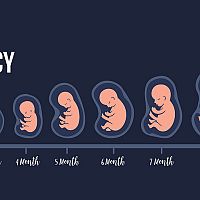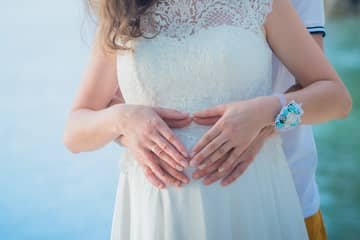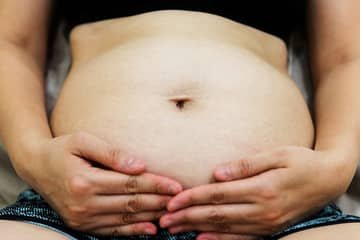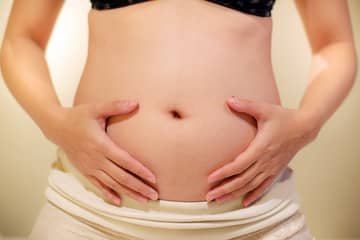
3rd week of pregnancy - symptoms, pain in the lower abdomen and the size of the fetus
In the second week during the ovulation phase, successful fertilization took place. Subsequently, the migration of the zygote (fertilized egg) began, but in the 3rd week of pregnancy, miotic cell division takes place, the so-called grooving. These processes are very important precisely so that the egg is firmly implanted in the uterus. The division itself during the journey through the fallopian tube ensures the development of the egg. This period is extremely sensitive. In the third week, the pregnancy hormone hCG is already present in some women, but you have to think about the fact that the egg does not have to be firmly embedded in the uterus yet. At the same time, the woman does not have to perceive that she is pregnant at all.
The migration phase, which began in the 2nd week of pregnancy, continues, and while until now the zygote has been the main role as the cell that carries the genes, now the development of the fertilized egg progresses and cell division ensures that the fertilized egg reaches the uterus as a blastocyst and it is successfully implanted so that an embryo can arise. However, this is something that usually only happens in the 4th week, and a total of 13 to 14 days pass from fertilization to this "climax". What happens in a woman's body during the 3rd week of pregnancy?
3rd week of pregnancy – a new life is born
It all started with the fertilization of a dominant egg by a man's sperm at the time of ovulation. By joining these cells, a cell called a zygote was formed in approximately 10 to 30 hours by division. It contains both mother's and father's genes. Specifically, it is the father's 23 chromosomes (XY) and the mother's 23 chromosomes (XX). These are crucial for determining the sex of the baby. The egg travels through the fallopian tube towards the uterus. Even before it gets there, however, it is necessary that further division processes take place. The zygote further divides into two blastomeres, then into four and eight cells. Then a morula with 16 cells is formed. During this entire process, in the 3rd week of pregnancy, the fertilized egg migrates through the fallopian tube into the uterus.
Approximately 5 days after fertilization, a blastocyst is created by the division of the morula, which consists of two types of cells. The trophoblast cells (outer) will ensure the development of the placenta after implantation, and the embryoblast cells (inner) are the ones that will play a role in the development of the baby. The blastocyst is a group of cells whose "mission" is to attach to the ideally prepared lining of the uterus and nestle (implant). Implantation continues for several days after the blastocyst enters the uterus. The whole process takes 13 to 14 days from fertilization. At the same time, this final phase is most likely to happen only in the 4th week, so it cannot be definitively said that there has been a successful implantation and creation of the embryo.
During this period, at the same time, "pregnancy" is extremely sensitive to various errors and harmful factors. It may happen that proper division does not occur and the egg is not retained. Statistically, up to 40% of the blastocysts that get into the uterus may eventually become stuck and an ectopic pregnancy may occur. The problem is also that the woman still generally does not know about her pregnancy, or may not know.
Did you know that it is already obvious in the initial phase whether you will be expecting a girl or a boy? A woman's chromosomes are labeled XX, a man is a carrier of XY chromosomes. If the man's sperm is an X-chromosome carrier, the fusion of the mother's X-chromosome and the father's X-chromosome means that it will be a girl. Conversely, if the sperm carries a Y chromosome and merges with the X chromosome from the mother (a woman only has XX chromosomes), the assumption is that it will be a boy.
Pain in the lower abdomen and symptoms in the 3rd week of pregnancy
We emphasize that a woman still may not know that she is pregnant during this period. With a high probability, even a pregnancy test will not confirm it yet, although the level of hormones in the body changes. Already during this period, the values of some hormones increase in the woman's body, and exceptionally, a pregnancy test can show a positive result with a faint line. One of the key hormones is progesterone. A woman may experience certain symptoms similar to those during ovulation or menstruation, but at the same time she may not experience anything unusual.
Women can perceive some symptoms very individually and attribute them to ovulation or regularly expected menstruation. Objectively, most women can hardly assess that a new life is being born in their body. Most likely, most of the following symptoms will appear only in the following weeks (from week 4). However, increased fatigue, sensitivity to smells, painful breasts, bloating or nausea may occur. The pregnancy will definitely not be visible on you. In the 3rd week of pregnancy, the belly does not notice any increase or other changes.
One of the symptoms that may indicate something, but is also likely to appear later, is implantation bleeding. This is associated with the implantation of the egg in the uterus. At the moment when the blastocyst attaches, the blood-filled lining of the uterus may be disturbed. The discharge is not intense, has a light red color and lasts only 1 to 2 days. It usually appears a week after ovulation, but it is definitely not the rule. As a rule, women attribute the implantation discharge to menstrual bleeding, because it overlaps with the expected period (week 4). Several women describe that they also felt pain in the lower abdomen with a stabbing or pulling character in the 3rd week. Most women attribute this pain to ovulation or approaching menstruation.

Multiple pregnancy
How does a multiple pregnancy occur? One scenario is that during the follicular phase, two (three or four...) viable - dominant eggs of the female develop, which are expelled during ovulation and meet two (three, four...) dominant sperm of the male. Subsequently, they will migrate together and if everything goes as it should, after nesting, two embryos will be born and they will be nourished by two placentas. Subsequently, fraternal twins will be born, which will look different.
The second possibility is that one dominant egg fertilized by one dominant sperm develops in such a way that two embryos are formed. When nesting, however, they will have only one placenta to feed them. Then we can talk about identical twins, who will look the same.
It is no coincidence that one egg was fertilized by two sperm and twins were born. As a rule, it happens that such an egg is not retained and will be expelled during the next menstruation as part of menstrual bleeding.
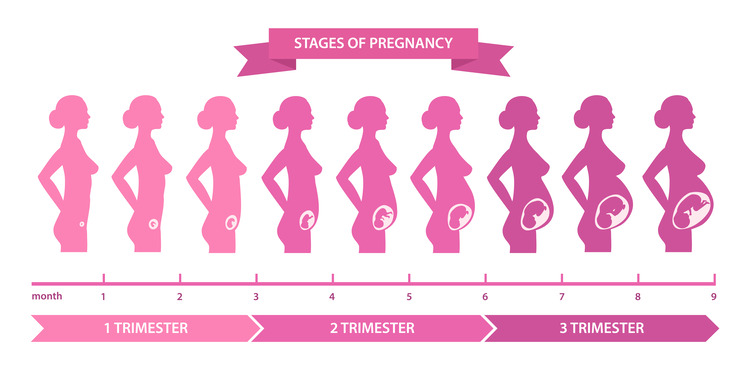
The most frequent questions - FAQ
Are you in the 3rd week of pregnancy and maybe you don't even know it? We believe that if you read our article, you may have a clearer understanding of what is happening in your body right now. Alternatively, you are at a more advanced stage and are interested in how it all went in the beginning. We will also be very happy if you share with us your opinions related to your feelings in the early stages of pregnancy. Have you experienced any symptoms that you attributed to early pregnancy? Have you had any complications? Join the discussion under the article.
3rd week of pregnancy, which month is it?
Is it appropriate to go for an ultrasound or sono in the 3rd week of pregnancy?
What if I have pain in the lower abdomen in the 3rd week of pregnancy?
Gallery
Pridať komentár

